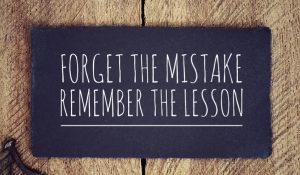Safe Space to Make Mistakes
Guest Editor – Kim Murphy
Making mistakes is a part of the learning process, and a fact of life.
Were you one of those learners who hated being wrong, so you didn’t raise your hand in class or shrunk in your seat to avoid being called on? I remember those days when I thought being wrong was the worst thing that could happen. Of course, it wasn’t – once I allowed myself to be okay with being wrong and to be open to learning from the feedback of others.
Making mistakes is a part of the learning process, and a fact of life, so while they may be hard to stomach, we might as well make something positive of the experience. Remember, if there were no experimentation and discovery, there would be no learning and advancement. As training professionals, we must foster a learning environment in which trainees feel comfortable taking risks and putting themselves in a space where they can learn and grow.
 Making mistakes and getting good feedback triggers creativity and offers opportunities to grow. This happens whether the mistakes are our own or the mistakes of others, if we remain open and honest to learn from them.
Making mistakes and getting good feedback triggers creativity and offers opportunities to grow. This happens whether the mistakes are our own or the mistakes of others, if we remain open and honest to learn from them.
Consider the new hires who are joining your company and have some experience in the therapeutic area. The team is thrilled to have them due to their experience and reputation. In class, you are trying to encourage the individuals to participate more actively and share their perspectives. Because of the training experienced at the previous company, this is a challenge for the new hire, because those volunteering to role-play were set up and made an example of. Those experiences leave the new hire reluctant to participate fully.
So, what can you do?
Kicking off your time together is an essential first step, but it is only one of many you must take to set and maintain a culture of learning.
As a training professional, you know this, but are you reiterating and demonstrating your commitment to creating a safe space on all engagements? Do you take time to ensure learners understand the intent is to provide them a safe space in which to grow and receive feedback? We can all use reminding of where we are and what the ground rules are, especially if this is new to your culture and when people are new to the culture. Saying it once before teaching several classes over the year is not enough. Don’t be afraid to encourage experimentation, within compliant guidelines, to see if a different approach gets you further in a conversation or within the results we are trying to achieve.
What are the ways that you do this in large and small groups? Do you regularly share this with your team, so people see different approaches to creating and maintaining the environment you want for your training? Do you have a prepped volunteer as your example? Do you ever use yourself as an example and invite a peer to give you feedback on what didn’t work well?
Only demonstrating the best practice from the start sets the wrong tone. Establishing and recommitting yourself to the process of learning shows your commitment, not only to their journey but your own. Remember, yours is an important journey too.
Kim Murphy is the associate director of learning strategy and operations for the commercial learning & development department at Takeda Pharmaceutical. Email Kim at kim.murphy1@takeda.com.








